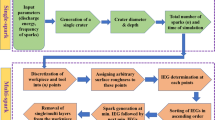Abstract
Electrochemical discharge machining (ECDM) has been studied numerically by several researchers using single spark simulation during finite element modeling (FEM) for analyzing the material removal rate (MRR). However, the process includes the stochastic nature of the spark striking that leads to complexities. Because of this randomness, FEM based multi-spark simulation has not attempted till date. This article attempts to develop an improved model based on a randomly oriented multi-sparks for estimating the MRR. Gradually growing spark behavior and Gaussian heat input are utilized for acquiring the temperature distributions within the work-material. The temperature distributions are further processed to evaluate the MRR with consideration of craters overlapping formed during the multi-spark occurrence. The predicted results exhibit a fair agreement with the experimental results. The simulation-based parametric studies are performed on MRR using applied voltage, electrolyte concentration, and energy transference since it influences the total heat input energy given by the sparks.
Similar content being viewed by others
References
R. Wüthrich and V. Fascio, Machining of non-conducting materials using electrochemical discharge phenomenon-an overview, Int. J. Mach. Tool. Manu., 45 (2005) 1095–1108.
V. Rajput, S. S. Pundir, M. M. Goud and N. M. Suri, Multi-response optimization of ECDM parameters for silica (quartz) using grey relational analysis, Silicon, 13 (2021) 1619–1640.
V. Rajput, M. M. Goud and N. M. Suri, Review-electrochemical discharge machining: gas film electrochemical aspects, stability parameters, and research work, J. Electrochem Soc., 168 (1) (2021).
M. M. Goud, A. K. Sharma and C. S. Jawalkar, A review on material removal mechanism in electrochemical discharge machining ECDM and possibilities to enhance the material removal rate, Precis. Eng., 45 (2016) 1–17.
H. Kurafuji and K. Suda, Electrical discharge drilling of glass, Ann CIRP, 16 (1968) 415–419.
M. M. Goud and A. K. Sharma, On performance studies during micromachining of quartz glass using electrochemical discharge machining, J. Mech. Sci. Technol., 31 (2017) 1365–1372.
B. K. Bhuyan and V. Yadava, Experimental modeling and multi-objective optimization of traveling wire electrochemical spark machining (TW-ECSM) process, J. Mech. Sci. Technol., 27 (2013) 2467–2476.
K. L. Bhondwe, V. Yadava and G. Kathiresan, Finite element prediction of material removal rate due to electro-chemical spark machining, Int. J. Mach. Tool. Manu., 46 (2006) 1699–1706.
M. M. Goud and A. K. Sharma, A three-dimensional finite element simulation approach to analyze material removal in electrochemical discharge machining, Proc. IMechE, Part C: J. Mechanical Engineering Science, 231 (2017) 2417–2428.
V. Rajput, M. M. Goud and N. M. Suri, Finite element modeling for analyzing material removal rate in ECDM, Journal of Advanced Manufacturing Systems, 19(4) (2020) 815–835.
V. Rajput, M. M. Goud and N. M. Suri, Finite element modeling based material removal analysis of non-conductive materials in ECDM using adaptive tool feed system, International Journal of Modern Manufacturing Technology, XII(1) (2020) 164–173.
C. Wei et al., A finite element-based model for electrochemical discharge machining in discharge regime, Int. J. Adv. Manuf. Technol., 54 (2011) 987–995.
A. Behroozfar and M. R. Razfar, Experimental and numerical study of material removal in electrochemical discharge machining (ECDM), Mater. Manuf. Processes, 31(4) (2015) 495–503.
M. C. Panda and V. Yadava, Finite element prediction of material removal rate due to traveling wire electrochemical sparks machining, Int. J. Adv. Manuf. Technol., 45 (2009) 506–520.
I. Basak and A. Ghosh, Mechanism of material removal in electrochemical discharge machining a theoretical model and experimental verification, J. Mater. Process. Tech., 71 (1997) 350–359.
A. Kulkarni, R. Sharan and G. K. Lal, An experimental study of discharge mechanism in electrochemical discharge machining, Int. J. Mach. Tool. Manu., 42 (2002) 1121–1127.
P. Yadav, V. Yadava and A. Narayan, Experimental investigation of kerf characteristics through wire electrochemical spark cutting of alumina epoxy nanocomposite, J. Mech. Sci. Technol., 32 (2018) 345–350.
V. Rajput, M. M. Goud and N. M. Suri, Numerical and experimental investigations to analyze the micro-hole drilling process in spark-assisted chemical engraving (SACE), SN Appl. Sci., 2 1525 (2020).
V. Rajput, M. M. Goud and N. M. Suri, Review on recent advances, research trends and gas film in electrochemical discharge-based micromachining, J. Micro Nano-Manuf., 9 (1) (2021).
Acknowledgment
The authors acknowledge the support and assistances given by the Punjab Engineering College, Chandigarh, India.
Author information
Authors and Affiliations
Corresponding author
Additional information
A Viveksheel Rajput is pursuing a Ph.D. degree in Production and Industrial Engineering Department from Punjab Engineering College (PEC), Chandigarh, India. He obtained his bachelor’s degree from Punjab Technical University, Punjab, Indian (2010), and completed his Master’s degree from PEC (2013). His area of research is non-conventional machining processes, Finite element modeling, composite materials. He has published more than 15 papers in reputed journals.
Mudimallana Goud is an Associate professor in the Production and Industrial Engineering Department, Punjab Engineering College, Chandigarh, India. He is the former Head of the department also. He obtained his Ph.D. degree from at Indian Institute of Technology Roorkee, Roorkee, India (2016). He has published more than 40 research papers in reputed journals. His prime area of research is Non-conventional machining and Advanced Machining Processes.
Narendra Mohan Suri is a Professor in the Production and Industrial Engineering Department, Punjab Engineering College, Chandigarh, India. Formerly, he is Head of Total Quality Management (TQM). He obtained his Ph.D. degree from at Indian Institute of Technology Delhi, Delhi, India (2005). He has published more than 80 research papers in reputed journals. His prime area of research is Welding Engineering, Casting, Composite Fabrication Al/Mg alloys casting.
Rights and permissions
About this article
Cite this article
Rajput, V., Goud, M. & Suri, N.M. Multi-spark simulation of the electrochemical discharge machining (ECDM) process. J Mech Sci Technol 35, 5127–5135 (2021). https://doi.org/10.1007/s12206-021-1029-7
Received:
Revised:
Accepted:
Published:
Issue Date:
DOI: https://doi.org/10.1007/s12206-021-1029-7




